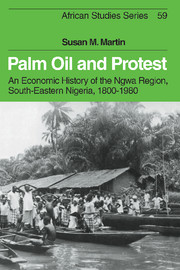Book contents
- Frontmatter
- Contents
- List of maps and figure
- Acknowledgements
- Abbreviations
- 1 Introduction
- 2 Ecology, society and economic change to 1891
- 3 The Ngwa and colonial rule, 1891–1914
- 4 The expansion of the oil palm industry, 1884–1914
- 5 The end of the boom
- 6 Cassava and Christianity
- 7 Authority, justice and property rights
- 8 Trade, credit and mobility
- 9 Production and protest: the Women Riot, 1929
- 10 Cash cropping and economic change, 1930–80
- 11 Conclusion
- Statistical appendix
- Notes
- Interviews conducted in the Ngwa region, 1980–1
- Bibliography
- Index
5 - The end of the boom
Published online by Cambridge University Press: 11 September 2009
- Frontmatter
- Contents
- List of maps and figure
- Acknowledgements
- Abbreviations
- 1 Introduction
- 2 Ecology, society and economic change to 1891
- 3 The Ngwa and colonial rule, 1891–1914
- 4 The expansion of the oil palm industry, 1884–1914
- 5 The end of the boom
- 6 Cassava and Christianity
- 7 Authority, justice and property rights
- 8 Trade, credit and mobility
- 9 Production and protest: the Women Riot, 1929
- 10 Cash cropping and economic change, 1930–80
- 11 Conclusion
- Statistical appendix
- Notes
- Interviews conducted in the Ngwa region, 1980–1
- Bibliography
- Index
Summary
In 1914 the prices paid for palm produce in Nigeria began a decline from which they never recovered. By 1920 the barter terms of trade for palm oil had slipped to 38 per cent of the 1913 level; and for palm kernels, to 30 per cent. Real export prices fluctuated below, but near these levels throughout the 1920s before falling sharply again in 1929–30 and 1933–4 to levels around 14 per cent of those of 1913 for both oil and kernels. The Second World War saw a further decline, to around 11 per cent of the 1913 level. Even during the boom which followed the Second World War, real price levels in Nigeria averaged only 28 per cent of the 1913 level for palm oil, and 22 per cent for palm kernels. After 1961 they began to fall sharply again.
Colonial administrators gradually became aware that the First World War marked the end of a period in which rising returns to labour could be obtained within the oil palm industry without innovation in production methods. They did not begin to engage directly in commercial palm production and trade until the Second World War, a period which lies outside the scope of this chapter. However, during and after the First World War they began reconsidering their policy towards the industry. It will be shown in this chapter that the seeds of later actions were sown in the policy debates and Agricultural Department experiments of this period. Two alternative strategies were developed, at least in theory; both of these were to be tried out in succession after 1939.
- Type
- Chapter
- Information
- Palm Oil and ProtestAn Economic History of the Ngwa Region, South-Eastern Nigeria, 1800–1980, pp. 56 - 66Publisher: Cambridge University PressPrint publication year: 1988

